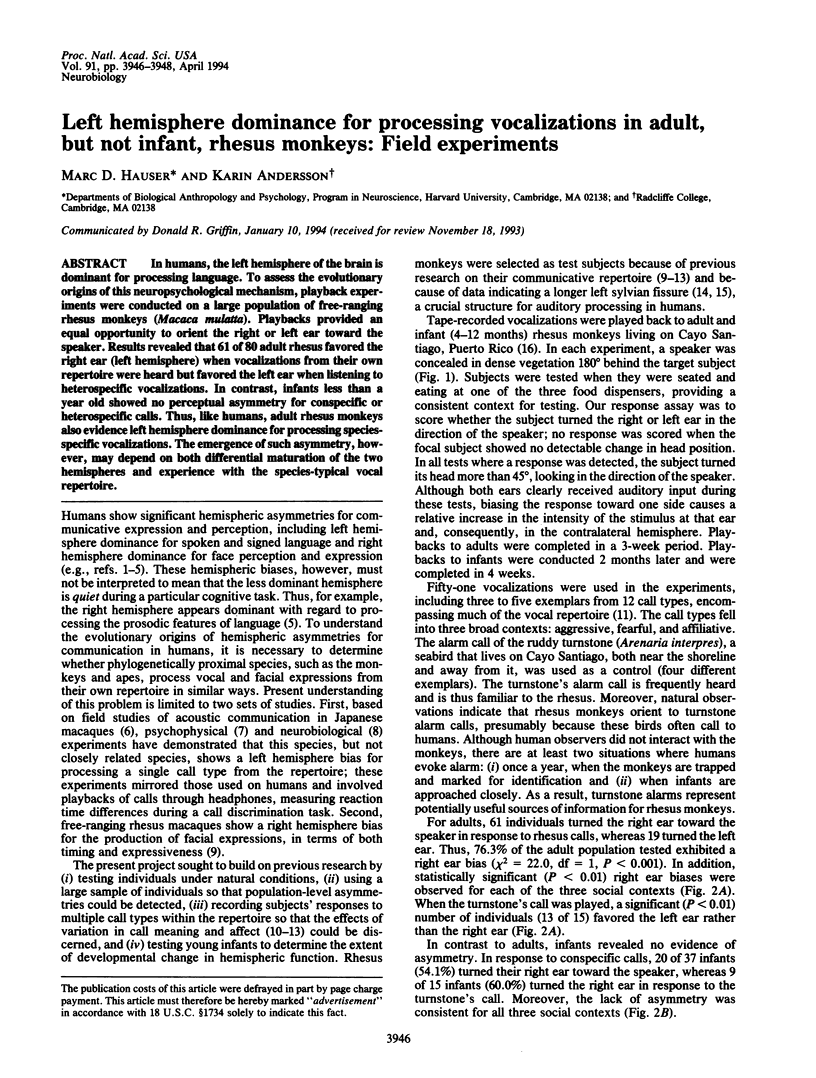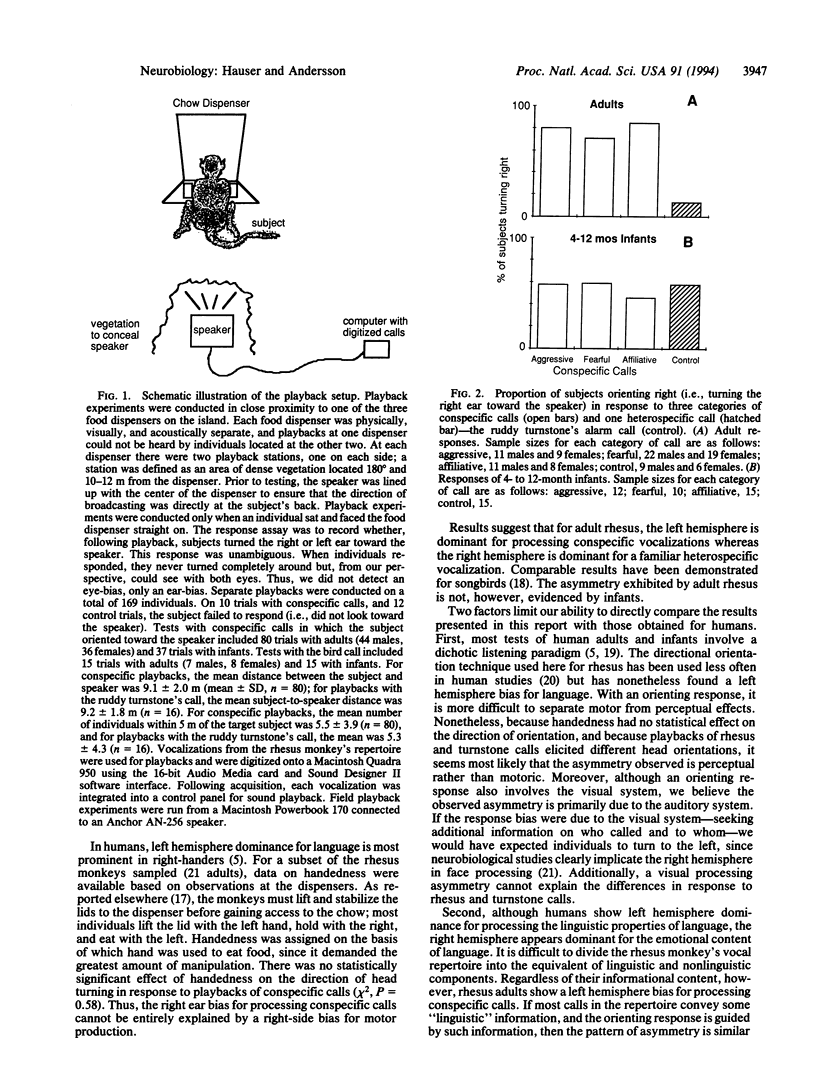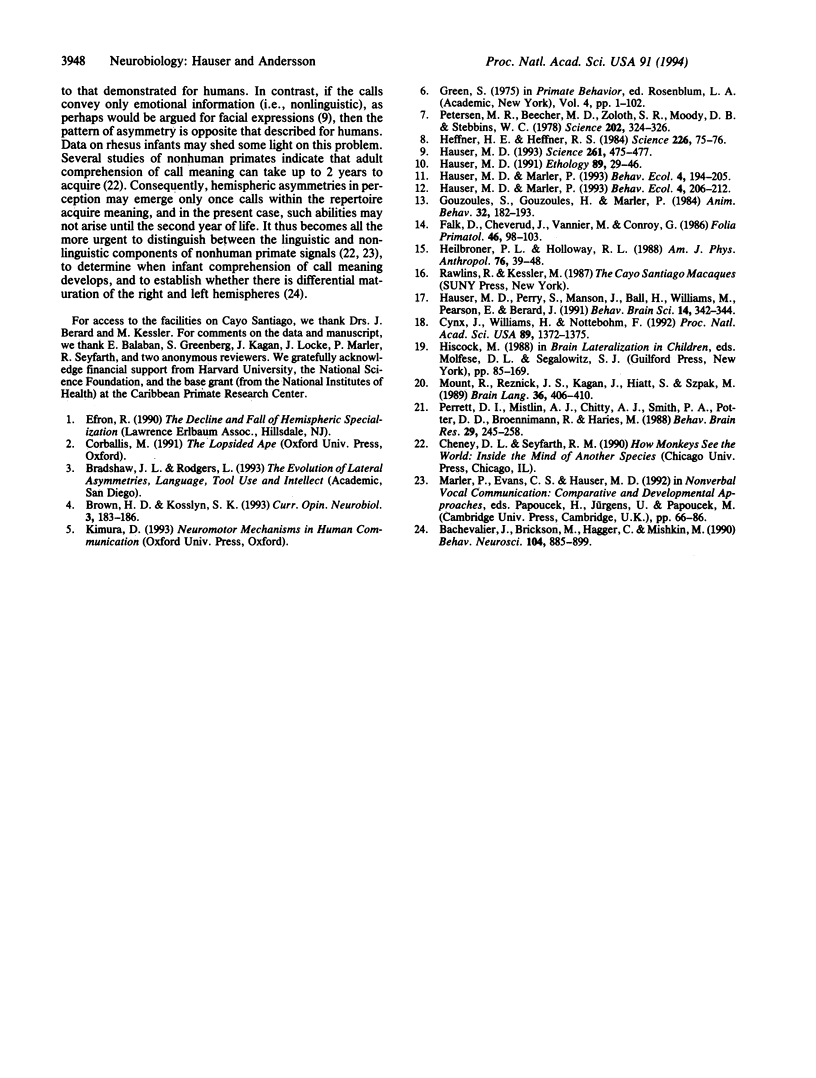Abstract
In humans, the left hemisphere of the brain is dominant for processing language. To assess the evolutionary origins of this neuropsychological mechanism, playback experiments were conducted on a large population of free-ranging rhesus monkeys (Macaca mulatta). Playbacks provided an equal opportunity to orient the right or left ear toward the speaker. Results revealed that 61 of 80 adult rhesus favored the right ear (left hemisphere) when vocalizations from their own repertoire were heard but favored the left ear when listening to heterospecific vocalizations. In contrast, infants less than a year old showed no perceptual asymmetry for conspecific or heterospecific calls. Thus, like humans, adult rhesus monkeys also evidence left hemisphere dominance for processing species-specific vocalizations. The emergence of such asymmetry, however, may depend on both differential maturation of the two hemispheres and experience with the species-typical vocal repertoire.
Full text
PDF


Selected References
These references are in PubMed. This may not be the complete list of references from this article.
- Bachevalier J., Brickson M., Hagger C., Mishkin M. Age and sex differences in the effects of selective temporal lobe lesion on the formation of visual discrimination habits in rhesus monkeys (Macaca mulatta). Behav Neurosci. 1990 Dec;104(6):885–899. doi: 10.1037//0735-7044.104.6.885. [DOI] [PubMed] [Google Scholar]
- Brown H. D., Kosslyn S. M. Cerebral lateralization. Curr Opin Neurobiol. 1993 Apr;3(2):183–186. doi: 10.1016/0959-4388(93)90208-g. [DOI] [PubMed] [Google Scholar]
- Cynx J., Williams H., Nottebohm F. Hemispheric differences in avian song discrimination. Proc Natl Acad Sci U S A. 1992 Feb 15;89(4):1372–1375. doi: 10.1073/pnas.89.4.1372. [DOI] [PMC free article] [PubMed] [Google Scholar]
- Falk D., Cheverud J., Vannier M. W., Conroy G. C. Advanced computer graphics technology reveals cortical asymmetry in endocasts of rhesus monkeys. Folia Primatol (Basel) 1986;46(2):98–103. doi: 10.1159/000156242. [DOI] [PubMed] [Google Scholar]
- Hauser M. D. Right hemisphere dominance for the production of facial expression in monkeys. Science. 1993 Jul 23;261(5120):475–477. doi: 10.1126/science.8332914. [DOI] [PubMed] [Google Scholar]
- Heffner H. E., Heffner R. S. Temporal lobe lesions and perception of species-specific vocalizations by macaques. Science. 1984 Oct 5;226(4670):75–76. doi: 10.1126/science.6474192. [DOI] [PubMed] [Google Scholar]
- Heilbroner P. L., Holloway R. L. Anatomical brain asymmetries in New World and Old World monkeys: stages of temporal lobe development in primate evolution. Am J Phys Anthropol. 1988 May;76(1):39–48. doi: 10.1002/ajpa.1330760105. [DOI] [PubMed] [Google Scholar]
- Mount R., Reznick J. S., Kagan J., Hiatt S., Szpak M. Direction of gaze and emergence of speech in the second year. Brain Lang. 1989 Apr;36(3):406–410. doi: 10.1016/0093-934x(89)90076-x. [DOI] [PubMed] [Google Scholar]
- Perrett D. I., Mistlin A. J., Chitty A. J., Smith P. A., Potter D. D., Broennimann R., Harries M. Specialized face processing and hemispheric asymmetry in man and monkey: evidence from single unit and reaction time studies. Behav Brain Res. 1988 Aug;29(3):245–258. doi: 10.1016/0166-4328(88)90029-0. [DOI] [PubMed] [Google Scholar]
- Petersen M. R., Beecher M. D., Zoloth S. R., Moody D. B., Stebbins W. C. Neural lateralization of species-specific vocalizations by Japanese macaques (Macaca fuscata). Science. 1978 Oct 20;202(4365):324–327. doi: 10.1126/science.99817. [DOI] [PubMed] [Google Scholar]


